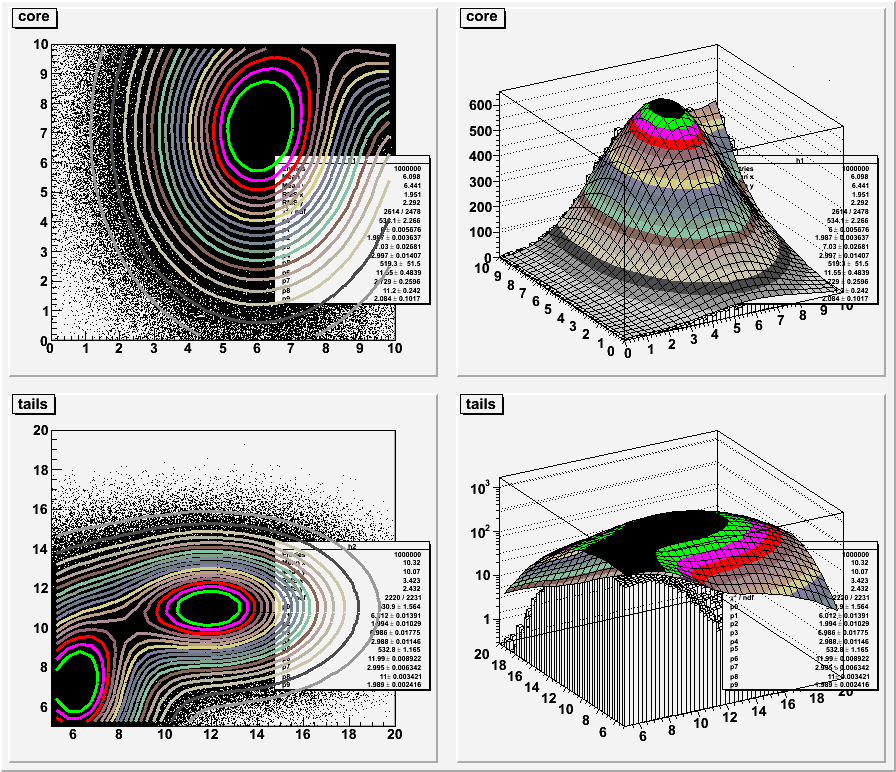#include "TH2D.h"
#include "TF2.h"
#include "TCanvas.h"
#include "TStyle.h"
#include "TRandom3.h"
#include "TVirtualFitter.h"
#include "TList.h"
#include <iostream>
double gauss2D(double *x, double *par) {
double z1 = double((x[0]-par[1])/par[2]);
double z2 = double((x[1]-par[3])/par[4]);
return par[0]*exp(-0.5*(z1*z1+z2*z2));
}
double my2Dfunc(double *x, double *par) {
return gauss2D(x,&par[0]) + gauss2D(x,&par[5]);
}
TRandom3 rndm;
TH2D *h1, *h2;
Int_t npfits;
void myFcn(Int_t & , Double_t * , Double_t &fval, Double_t *p, Int_t )
{
TAxis *xaxis1 = h1->GetXaxis();
TAxis *yaxis1 = h1->GetYaxis();
TAxis *xaxis2 = h2->GetXaxis();
TAxis *yaxis2 = h2->GetYaxis();
int nbinX1 = h1->GetNbinsX();
int nbinY1 = h1->GetNbinsY();
int nbinX2 = h2->GetNbinsX();
int nbinY2 = h2->GetNbinsY();
double chi2 = 0;
double x[2];
double tmp;
npfits = 0;
for (int ix = 1; ix <= nbinX1; ++ix) {
x[0] = xaxis1->GetBinCenter(ix);
for (int iy = 1; iy <= nbinY1; ++iy) {
if ( h1->GetBinError(ix,iy) > 0 ) {
x[1] = yaxis1->GetBinCenter(iy);
tmp = (h1->GetBinContent(ix,iy) - my2Dfunc(x,p))/h1->GetBinError(ix,iy);
chi2 += tmp*tmp;
npfits++;
}
}
}
for (int ix = 1; ix <= nbinX2; ++ix) {
x[0] = xaxis2->GetBinCenter(ix);
for (int iy = 1; iy <= nbinY2; ++iy) {
if ( h2->GetBinError(ix,iy) > 0 ) {
x[1] = yaxis2->GetBinCenter(iy);
tmp = (h2->GetBinContent(ix,iy) - my2Dfunc(x,p))/h2->GetBinError(ix,iy);
chi2 += tmp*tmp;
npfits++;
}
}
}
fval = chi2;
}
void FillHisto(TH2D * h, int n, double * p) {
const double mx1 = p[1];
const double my1 = p[3];
const double sx1 = p[2];
const double sy1 = p[4];
const double mx2 = p[6];
const double my2 = p[8];
const double sx2 = p[7];
const double sy2 = p[9];
const double w1 = 0.5;
double x, y;
for (int i = 0; i < n; ++i) {
rndm.Rannor(x,y);
double r = rndm.Rndm(1);
if (r < w1) {
x = x*sx1 + mx1;
y = y*sy1 + my1;
}
else {
x = x*sx2 + mx2;
y = y*sy2 + my2;
}
h->Fill(x,y);
}
}
int fit2dHist(int option=1) {
int nbx1 = 50;
int nby1 = 50;
int nbx2 = 50;
int nby2 = 50;
double xlow1 = 0.;
double ylow1 = 0.;
double xup1 = 10.;
double yup1 = 10.;
double xlow2 = 5.;
double ylow2 = 5.;
double xup2 = 20.;
double yup2 = 20.;
h1 = new TH2D("h1","core",nbx1,xlow1,xup1,nby1,ylow1,yup1);
h2 = new TH2D("h2","tails",nbx2,xlow2,xup2,nby2,ylow2,yup2);
double iniParams[10] = { 100, 6., 2., 7., 3, 100, 12., 3., 11., 2. };
TF2 * func = new TF2("func",my2Dfunc,xlow2,xup2,ylow2,yup2, 10);
func->SetParameters(iniParams);
int n1 = 1000000;
int n2 = 1000000;
FillHisto(h1,n1,iniParams);
FillHisto(h2,n2,iniParams);
double dx1 = (xup1-xlow1)/double(nbx1);
double dy1 = (yup1-ylow1)/double(nby1);
double dx2 = (xup2-xlow2)/double(nbx2);
double dy2 = (yup2-ylow2)/double(nby2);
h2->Sumw2();
h2->Scale( ( double(n1) * dx1 * dy1 ) / ( double(n2) * dx2 * dy2 ) );
bool global = false;
if (option > 10) global = true;
if (global) {
std::cout << "Do global fit" << std::endl;
if (option%10 == 2) TVirtualFitter::SetDefaultFitter("Minuit2");
else TVirtualFitter::SetDefaultFitter("Minuit");
TVirtualFitter * minuit = TVirtualFitter::Fitter(0,10);
for (int i = 0; i < 10; ++i) {
minuit->SetParameter(i, func->GetParName(i), func->GetParameter(i), 0.01, 0,0);
}
minuit->SetFCN(myFcn);
double arglist[100];
arglist[0] = 0;
minuit->ExecuteCommand("SET PRINT",arglist,2);
arglist[0] = 5000;
arglist[1] = 0.01;
minuit->ExecuteCommand("MIGRAD",arglist,2);
double minParams[10];
double parErrors[10];
for (int i = 0; i < 10; ++i) {
minParams[i] = minuit->GetParameter(i);
parErrors[i] = minuit->GetParError(i);
}
double chi2, edm, errdef;
int nvpar, nparx;
minuit->GetStats(chi2,edm,errdef,nvpar,nparx);
func->SetParameters(minParams);
func->SetParErrors(parErrors);
func->SetChisquare(chi2);
int ndf = npfits-nvpar;
func->SetNDF(ndf);
h1->GetListOfFunctions()->Add(func);
h2->GetListOfFunctions()->Add(func);
}
else {
h1->Fit(func);
h2->Fit(func);
}
TCanvas * c1 = new TCanvas("c1","Two HIstogram Fit example",100,10,900,800);
c1->Divide(2,2);
gStyle->SetOptFit();
gStyle->SetStatY(0.6);
c1->cd(1);
h1->Draw();
func->SetRange(xlow1,ylow1,xup1,yup1);
func->DrawCopy("cont1 same");
c1->cd(2);
h1->Draw("lego");
func->DrawCopy("surf1 same");
c1->cd(3);
func->SetRange(xlow2,ylow2,xup2,yup2);
h2->Draw();
func->DrawCopy("cont1 same");
c1->cd(4);
h2->Draw("lego");
gPad->SetLogz();
func->Draw("surf1 same");
return 0;
}
|
|
